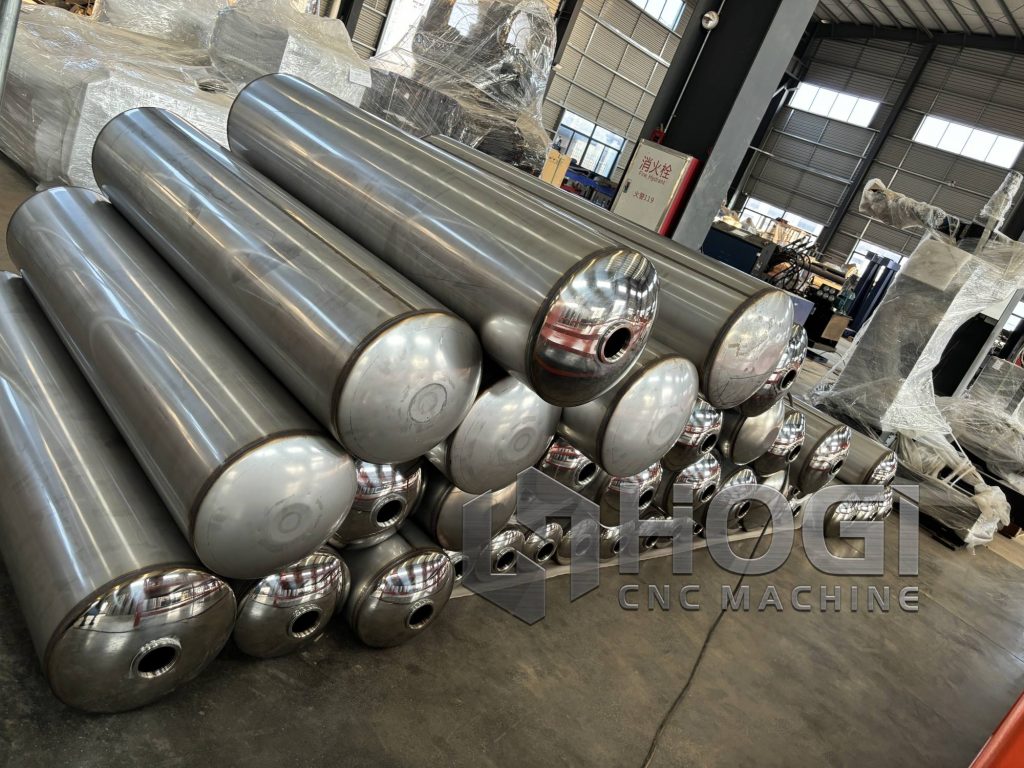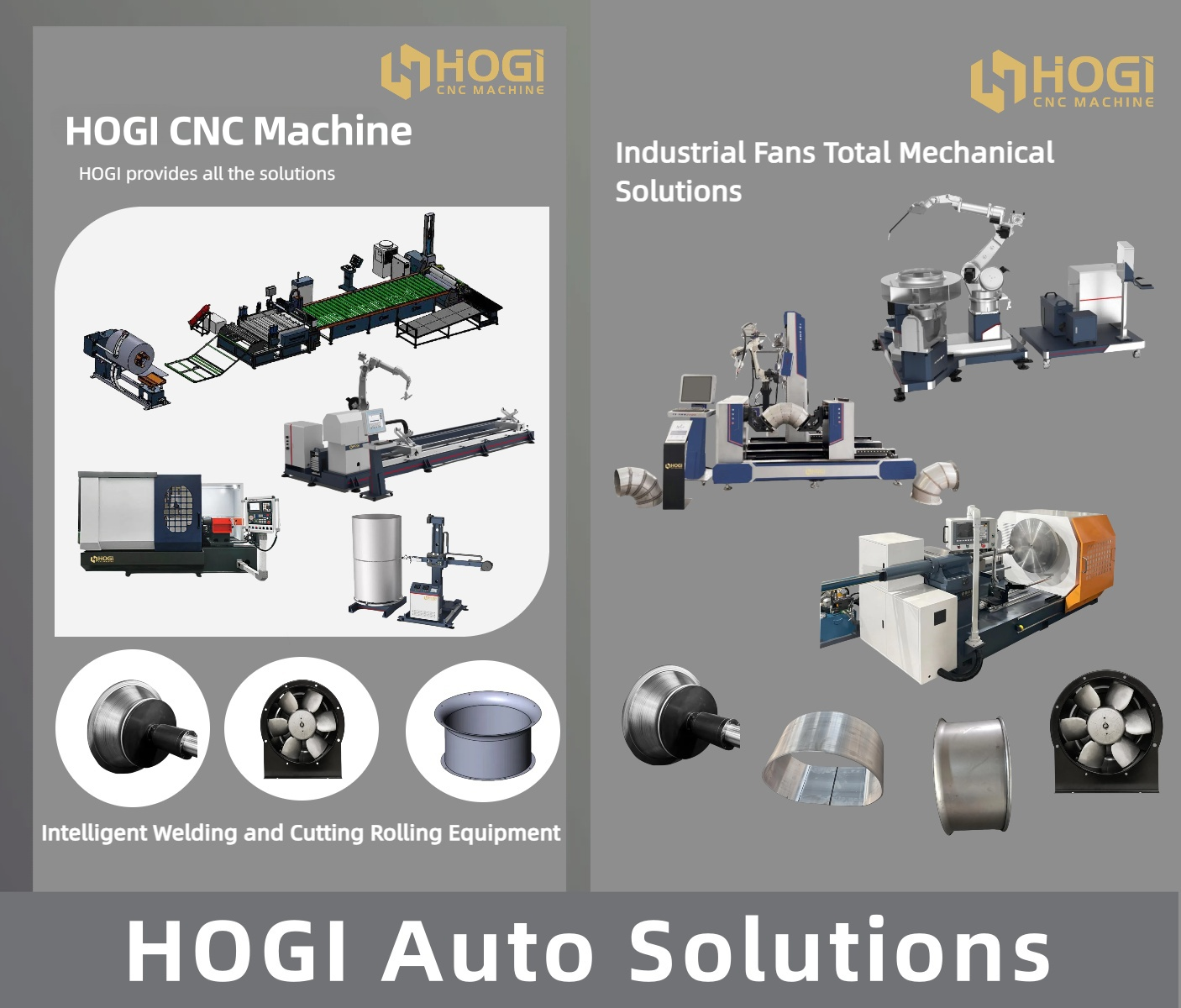In the pressure vessel manufacturing industry, welding process has always been an important factor affecting product quality and safety performance. Especially for high-standard gas containers such as fluorine gas tanks, the sealing, strength and consistency of weld seams are highly required. HOGI self-developed laser weld tracking sensor, with its high-precision identification and real-time deviation correction capabilities, is becoming an important technology for the intelligent upgrading of welding equipment, and has an irreplaceable role to play in fluorine tanks and other application scenarios that require high precision and stability.
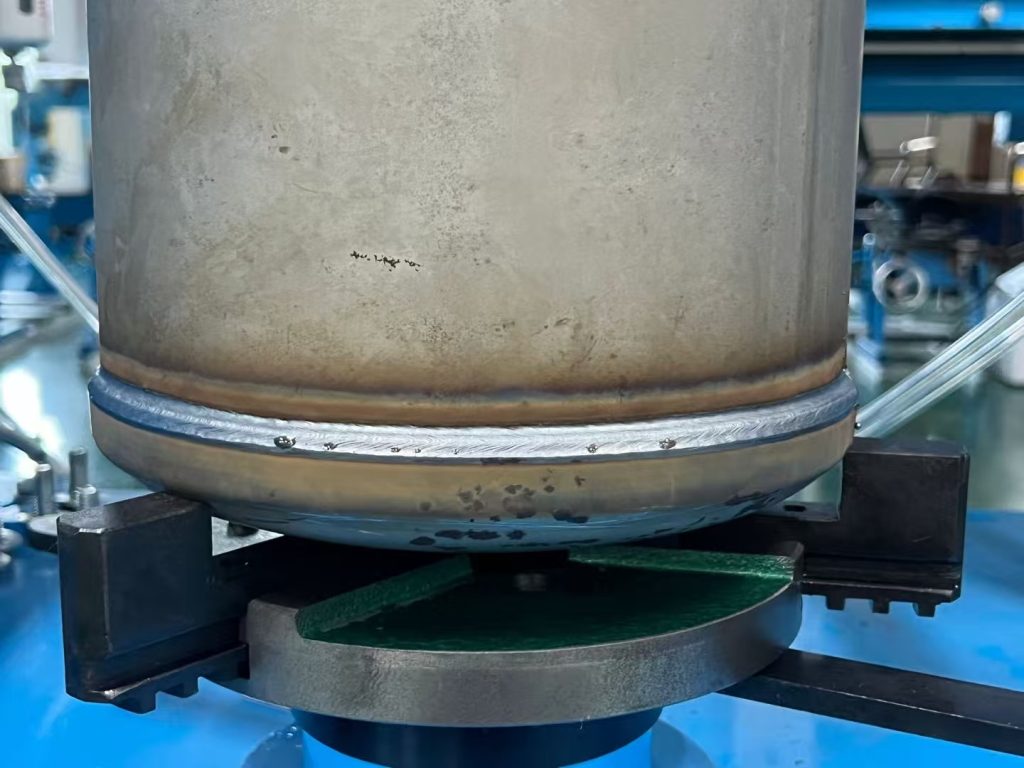
Laser seam tracking sensors:
HOGI laser weld tracking sensor collects real-time information about the position, shape and height of the weld seam through laser profile scanning technology. The system has built-in intelligent recognition algorithms, which can automatically identify different types of weld feature points, such as bevel centers, fusion edges, etc., and correct the left, right, and up/down deviations of the welding torch in real time according to the scanning data.
Compared with the traditional manual repeated teaching methods, weld tracking sensors to realize, automatic identification of weld information, intelligent planning of welding trajectory, for complex components of high-precision automated welding provides a technical guarantee, especially for gas containers, pressure equipment, and other industries requiring high consistency of welding quality.
Automatic welding challenges for fluorine gas tanks:
1. Complex structure: fluorine gas tanks are usually cylindrical or shaped structure, the weld path is curved and changeable, and the control of welding trajectory requires higher;
2. Serious thermal deformation: welding process heat input is large, easy to cause the workpiece deformation increases, weld position offset;
3. Cumbersome teaching: The traditional teaching method requires manual point-by-point programming, which is not only time-consuming and laborious, but also difficult to cope with batch changes;
4. High precision requirements: Fluorine gas tanks have strict standards for weld sealing and molding quality, and minor weld deviations may affect product safety.
Advantages of laser weld tracking systems:
The integration of the HOGI laser seam tracking system in the special machine for welding of fluorine gas tanks significantly improves the intelligence of the welding process, with the following main advantages:
1. Automatic identification of weld positions: real-time scanning of weld seams without relying on fixed trajectories or teaching paths;
2. Dynamic deskew guidance torch: Intelligent adjustment of the welding path according to the scanning results to cope with deformation and clamping errors;
3. More stable welding quality: avoid problems such as bias welding, false welding and burn-through, and improve the consistency of weld molding;
4. Reduce manual intervention: one key to start the automatic tracking, significantly reduce the time of manual instruction and adjustment;
5. Enhance productivity: After the automation degree is increased, the overall welding beat is significantly optimized and the unit output is increased.
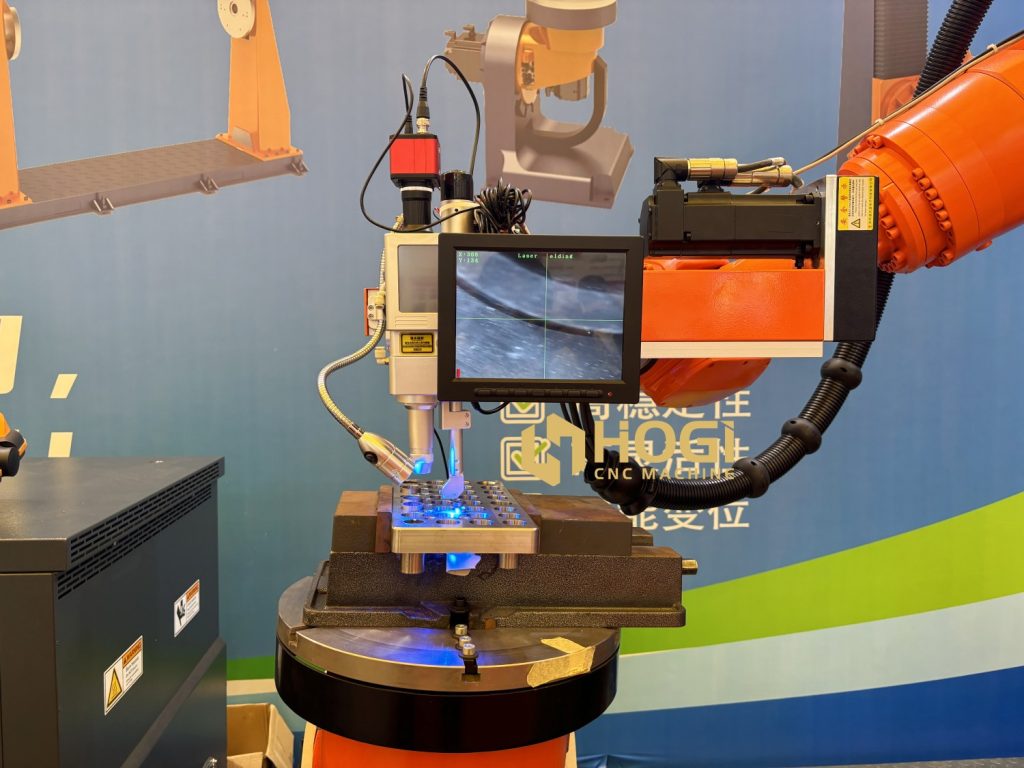
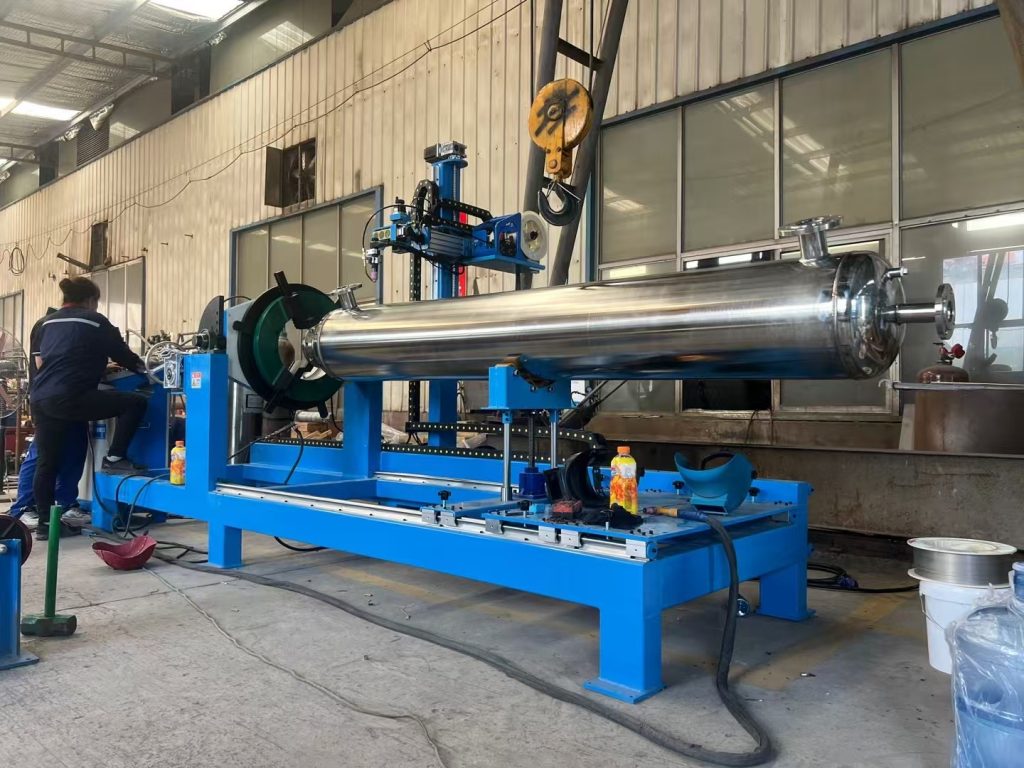
Applications:
After a gas equipment manufacturer integrated HOGI laser seam tracking system into a special welding machine for fluorine gas tanks, the welding efficiency and quality have been greatly improved. The problem of bias welding caused by workpiece deformation and clamping errors is effectively solved by using the real-time tracking function; the system can adapt to the small size differences between different batches of products without frequent manual instruction, reducing the rate of welding rework.
In the face of manufacturing upgrading and market competition, welding automation technology is becoming an important means for enterprises to break through bottlenecks, and HOGI high-precision laser weld tracking technology has injected intelligent assistance for the pressure vessel manufacturing industry. In the future, HOGI will continue to plough into the field of welding intelligence, provide more stable, more flexible and more efficient solutions, and work with more manufacturing enterprises towards a new era of intelligent manufacturing.
Carbon steel tank welding technology analysis
Carbon steel tanks are containers made of carbon steel and are widely used in many fields. Carbon steel tank is a storage equipment made of steel mesh (tortoise shell) welded to the surface of the tank by a special process, using rotomolding one-shot molding process. It has the characteristics of no joints, no leakage, no toxicity, anti-aging, impact resistance, corrosion resistance, long life and composite health standard.
Carbon steel tank welding technology classification:
1. Electrode arc welding
Principle: Using the arc heat generated between the electrode and the weldment, the electrode and the weldment are locally melted to form a molten pool, which is then cooled and solidified to form a weld.
Advantages: simple equipment, flexible operation, suitable for welding in various positions, relatively low requirements for the welding environment, can be welded in the field or under poor site conditions.
Disadvantages: high labor intensity, relatively low productivity, welding quality is affected by the technical level of the welder, and the welding process will produce more smoke and spatter.
Application Scenario: Commonly used in small carbon steel tank repair, reconstruction and some of the higher requirements for the welding position, irregular shape of the tank welding. For example, in some small chemical enterprises in the carbon steel tank repair work, welding rod arc welding is a common welding method.
2. Submerged arc automatic welding:
Principle: The arc is buried under the flux layer and burned, and the wire is continuously fed through the automatic wire feeding device to form a weld on the weldment.
Advantages: high welding efficiency, stable weld quality, less fume and spatter produced in the welding process, good labor conditions. As it is automatic welding, it can reduce the influence of human factors on welding quality.
Disadvantages: Higher cost of equipment, higher requirements for the assembly precision of the weldment, and only applicable to flat welding or welding position with small inclination angle.
Application Scenario: It is suitable for mass production welding operations such as flat plate splicing and ring seam welding of large carbon steel tanks. For example, the ring seam welding of the wall of large oil storage tanks can improve the welding efficiency and quality by using submerged arc automatic welding.
3. Tungsten grade argon arc welding:
Principle: The tungsten grade is used as the electric grade, and under the protection of argon gas, the arc heat between the tungsten grade and the weldment is utilized to melt the weldment to form a weld seam.
Advantages: welding process argon on the molten pool of the protection effect is good, can effectively prevent the weld metal is oxidized, welding quality is high, suitable for welding thin plate and welding quality requirements of higher parts.
Disadvantages: Relatively slow welding speed, higher cost, higher technical level requirements for welders.
Application Scenario: Commonly used in the internal weld welding of carbon steel tanks, welding of joint welds between the receiver and the tank, and other parts that require high welding quality. For example, carbon steel tanks in the food processing industry, the internal weld in order to avoid contamination of food, usually using tungsten-grade TIG welding for welding.
4. Melting grade gas shielded welding:
Principle: Use the melting wire as the electric level, under the protection of inert gas or active gas, through the arc heat between the wire and the weldment to make the wire and the weldment melt to form a weld.
Advantages: high welding efficiency, large depth of fusion, suitable for welding of medium-thick plates, and the adaptability of the welding position is strong.
Disadvantages: the equipment is more complex, the purity of the gas and flow requirements are higher, if the gas protection is poor in the welding process, it is easy to produce porosity and other defects.
Application Scenario: In the manufacture of carbon steel tanks, it can be used for the welding of tank walls, tank tops and other parts, especially for some larger thicknesses of carbon steel plate welding has advantages.
5. Automatic welding technology:
Principle: The welding process is controlled by automated equipment, including welding robots and automatic welding trolleys. These devices can weld according to preset programs and parameters, realizing high-precision welding.
Advantages: stable welding quality, high productivity, can reduce the labor intensity of welders, and can work in harsh environments.
Disadvantages: High investment cost of the equipment, high requirements on the shape and size of the welded parts, and the need for specialized technicians to carry out programming and debugging.
Application Scenario: Suitable for mass production of large carbon steel tanks, such as large petroleum tanks, chemical tanks and other manufacturing.
Carbon steel tank tungsten grade argon arc welding technology applicable scenes:
Industries with high demands on welding quality:
- Carbon steel tanks for food and pharmaceutical industries:
The above industries require a high level of sealing and cleanliness of the tanks, and do not allow any impurities or leaks in the welds. Tungsten-grade TIG welding can provide high-quality welds to avoid contamination of the product and ensure the safety and reliability of the tanks. For example, in the process of food processing, carbon steel tanks for storing raw materials or finished products, if tungsten-grade TIG welding is used to weld the internal weld seam, it can effectively prevent metal oxides and other impurities at the weld seam from mixing into the food, ensuring the quality and safety of food.
2. Carbon steel tanks for high-precision instruments and equipment:
Certain high-precision instruments and equipment need to operate under specific environmental conditions, and the welding quality of carbon steel tanks supporting them is strictly required. Tungsten-grade TIG welding can ensure the flatness and uniformity of the weld, reduce the instability caused by welding defects in the operation of the equipment. For example, some laboratories in the gas storage carbon steel tanks, the use of tungsten argon arc welding can ensure the sealing of the tank to prevent gas leakage affect the accuracy of the experimental results.
Thin plate welding:
1. Small carbon steel tanks:
For some small carbon steel tanks, its wall thickness is thin, the use of tungsten-grade TIG welding can better control the welding heat input, to avoid deformation of thin plate. For example, some small experimental carbon steel tanks, due to its small size and thin wall, the use of tungsten-grade TIG welding can ensure the welding quality at the same time, reduce the impact of welding deformation on the tank structure.
2.Carbon steel tanks with high demands on appearance:
In some special occasions, carbon steel tanks not only need to have good performance, but also have high requirements for appearance. The weld seam of tungsten grade argon arc welding has beautiful molding and smooth surface, which can meet these special needs. For example, in some display or decorative carbon steel tank production, tungsten argon arc welding can make the weld and the tank as a whole into one, enhance the beauty of the tank.
Welding in special environments:
1. Confined space welding:
In some narrow space for carbon steel tank welding, tungsten-grade argon arc welding equipment is relatively small, flexible operation, easy to carry out welding operations in a limited space. For example, in some pipelines installed in a dense area of small carbon steel tanks, the use of tungsten-grade TIG welding can overcome the space limitations and complete high-quality welding.
2. Environment with cleanliness requirements:
In some occasions that require high environmental cleanliness, such as welding carbon steel tanks near electronic chip manufacturing workshops, hospital operating rooms, etc., tungsten-grade argon arc welding produces less fume and spatter, which can keep the environment clean. At the same time, the welding method will not produce harmful welding residue, to avoid pollution of the surrounding environment.
